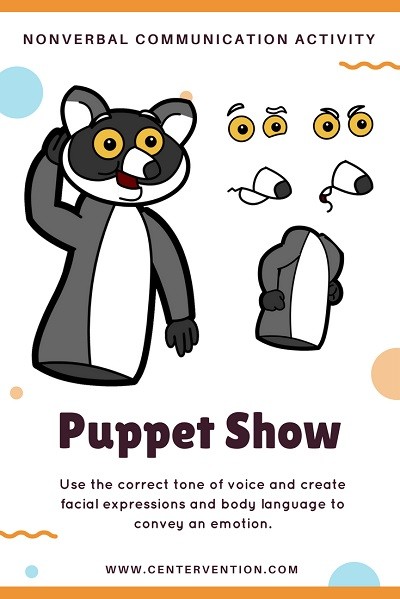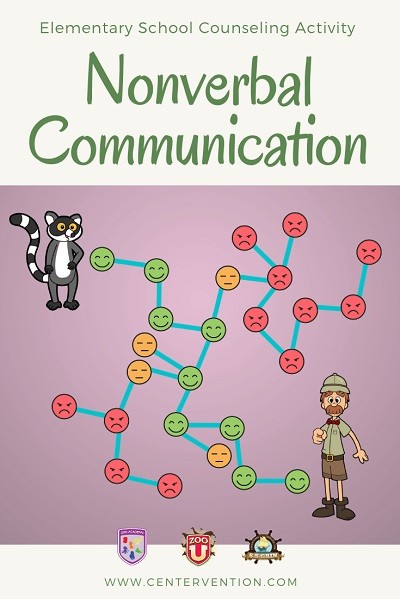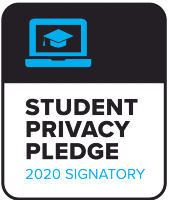Nonverbal communication activities are a great way to enhance critical social and emotional skills, including knowledge of voice inflection, facial expressions, and body language.
In this activity, students will practice for a puppet show by reading scripts, and feeling words indicate what emotion should be conveyed while saying the line. Students will read and give each other feedback on how to change their tone of voice to match the emotion. Students will then use cut-outs of a lemur and a hedgehog to create different puppets for the different emotions. Note: This activity is based on one of a Zoo U game scene in which players work with a classmate to construct lemur and hedgehog puppets that represent various emotions, then perform a puppet show.
Students will: learn to show clear nonverbal communication, use the correct tone of voice to convey an emotion, and identify components of facial expressions and body language to convey an emotion.
Discussion:
- When we’re talking to someone, what are some things we should pay attention to besides the words we’re using?
- How can things like tone of voice, facial expressions, body language, and other nonverbal communication change the meaning of the words we are saying?
The message of this activity is that when we are talking to someone, the words we choose to use are only one thing that help us get our meaning across. We also need to think about what expression we have on our face (facial expression), HOW we say the words (tone of voice), and how we hold our body (body language). If any of those things don’t match each other, it’s more likely the person we are talking to will be confused.

In these worksheets, scaffolded by grade level, students will identify positive and negative expressions and emotion words to successfully navigate a maze to the finish.
Deciphering the meaning of other’s positive and negative expressions can be difficult, especially when someone is saying one thing out loud while their face is silently saying something else.
The K-1 worksheet features baby Lyla from our K-1 program, Zoo Academy, who needs help delivering a note to Mrs. Howard on the other side of a maze. Students must color in all of the different happy face emojis to lead them through the maze.
The 2nd-4th grade worksheet similarly features Lyla from Zoo U who needs help delivering a note to Principal Wild on the other side of the maze. This worksheet mixes in emotion words with emojis for an added challenge to complete the maze.
The 3rd-5th grade worksheet features the avatar from SS GRIN, who needs to navigate facial expressions and words to get the friendship stone to CK (Communication Kid). All of the lines in this “maze” are gone, so students will not be able to rely on clues from the maze itself as to which direction to go.
Use any or all of these nonverbal communication activities and worksheets with your students in different grade levels to help them improve their communication skills!

These nonverbal communication activities allows students to learn the art of people watching by becoming a “social spy,” observing people’s actions to figure out how they may be feeling.
The directions for the activity instruct students to Find a place where they can quietly observe other people, like the playground, the grocery store, or on the street. (If they don’t have the opportunity to observe people in public safely, they can observe characters on a TV show). Students will then fill out the worksheet based on the people they see.
The worksheet asks students to look for people they think are displaying a certain emotion, like someone who looks happy. How do you know they are happy? What are they doing? What does they face look like? Are they smiling, laughing? What does their body language look like? If they have their arms crossed or fists balled up, are they happy?
How about a person who is alone? How can you tell how they are feeling?
The activity also asks students to describe someone who they aren’t sure how they are feeling. Maybe they are crying, but they are also smiling. Maybe they laughed but then went back to frowning. These displays of mixed body language or facial expressions could be confusing to kids, but would be a great opportunity to talk about how sometimes emotions can be mixed up, or how sometimes people try to hide how they are feeling, such as laughing when they are actually sad.
If you don’t typically assign students social skills homework, consider doing this nonverbal communication lesson with a small group at school. Go to the recess yard or cafeteria and observe people together. Help students notice different body language like facing into or away from the other person while two people are talking. Help students identify which facial expressions indicate excitement and which indicate anger or fear. You could then send an extra worksheet home for students to practice again, whether alone or with their families.

